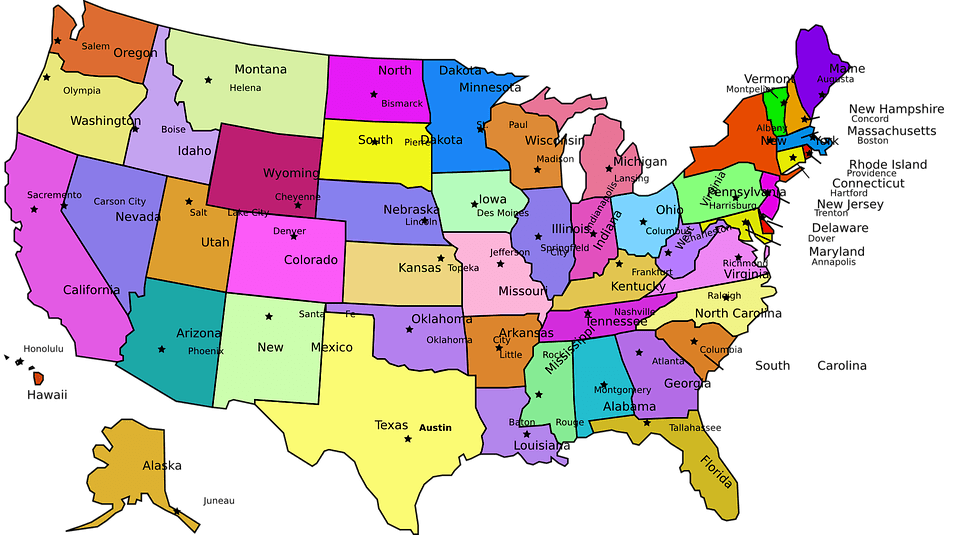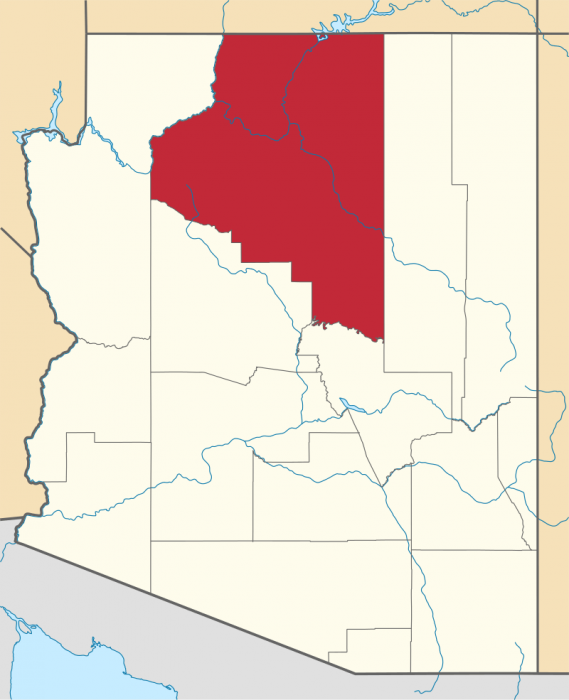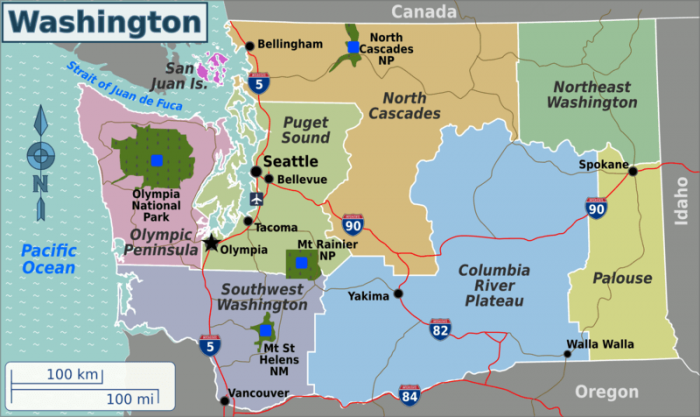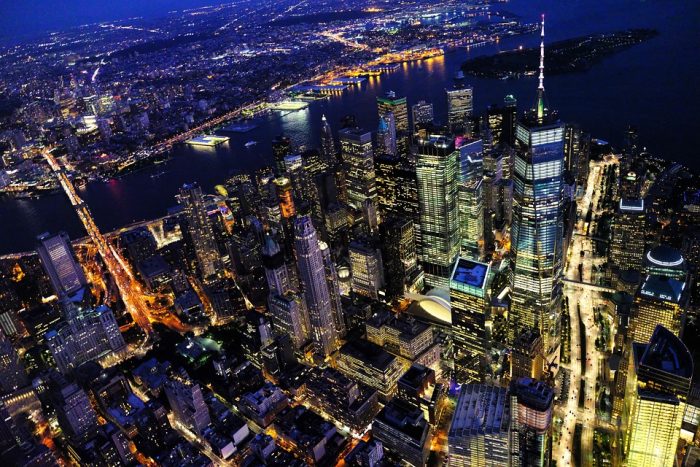
How many cities are there within the United States, or how many cities are officially recognized by the US government? Answering this question requires going into the distinction between cities, towns, and counties. However, this article will use “incorporated places” as the relevant term to get the most complete picture of cities and towns within the US.
Defining Counties, Cities and Towns
Asking how many cities in the United States is a difficult question to answer because many states have their own definitions of cities, and some states don’t even use the terms county or town. In practice, trying to figure out exactly how many cities are in the US is like trying to determine how many groups of people are within the US, as divided by some chosen criteria. In order to make any sort of progress with this question, we will need to define our terms first.

Arizona divided into its counties. the county in red is Coconino county. Photo: By Own work. – v.1: David Benbennick; v.2: File:USA Arizona location map.svg, Public Domain, https://commons.wikimedia.org/w/index.php?curid=569878
As defined by the United States Census Bureau, counties are large governing bodies, larger than the city and they frequently include many townships and cities within them. Most counties are functional governmental units, and they are the primary legal division for most states. Counties may also be referred to as boroughs, census areas, municipalities, or parishes.
Subdivisions of counties are referred to as Minor Civil Divisions or MCDs by the Census Bureau. They are made out of both nonstate functioning administrative entities and out of governmentally functioning entities. The functions and legal powers that an MCD possesses will change from state to state. Towns are commonly regarded as MCDs in states like New York, Wisconsin, and regions like New England.
The Census Bureau regards most towns, cities, boroughs, villages, and “other lesser-known identifiers” as incorporated places. The functions, legal powers, and legal designations given to incorporated places changes from state to state. The boundaries of incorporated places are flexible and can sometimes cross MCD boundaries and county boundaries. Take note that the incorporated places category does not include townships. Townships are unincorporated areas, usually in rural areas throughout the Northeast and Midwest. Townships are frequently used to provide basic services like EMTs, fire response teams, and police to surrounding areas, as well as maintain roads in rural areas.

Map of Washington state and its major cities. Photo: Peter Fitzgerald, David Benbennick, Shaundd via Wikimedia Commons, CC-BY-SA 4.0
Consolidated cities referred to cities that have had the functions of an MCD or a parent county/incorporated place merged together, creating a governmental unit with powers and functions which are the combined functions of the individual areas. The main incorporated place within the merged MCD or County is referred to as the consolidated city. While there can be one or more incorporated places within the overlapping region, these individual places continue to function as unique governmental units, they do not leave all functions and decisions up to the main consolidated city.
The exact distinction between a city and a town is fuzzy, with definitions changing from place to place. However, for many places in the US, neighborhoods, communities, villages, towns are simply unincorporated communities that have no governmental powers of their own. For these unincorporated communities, county governments usually provide them with the services that they need. However, some states do indeed have official town designations which give these towns certain limited powers.
Beyond the categories of incorporated places, counties, and consolidated cities the Census Bureau also recognizes some other categories such as independent school districts and special districts. Independent school districts are not run by a city, and they frequently encompass multiple townships or cities. These areas only serve schools and do not govern an entire area. Special districts are very similar to independent school districts, but the special districts are set up for the purposes of maintaining a particular service such as EMTs or fire departments.
How Many Incorporated Places Within The US?
Now that we define our terms, we can set about answering the question of how many incorporated places there are within the US. However, a comprehensive list of all incorporated places and districts in the United States is extremely difficult to come by.
A 2012 Census Bureau release claimed that there were 89,004 local governments within the United States, having dropped from 2007’s number of 89,476 local government areas. The local governments included in the 2012 census included approximately 3031 counties, 19,522 municipalities (incorporated places), an estimated 16,364 townships, 12,884 independent school districts, and roughly 37,200 special districts.
This means that if one is counting only incorporated places, there is around 19, 522 incorporated places in the US as of the 2012 census. However, if one includes townships (remember that these are unincorporated) then this number becomes 35,886. The 2017 census finds that at least 769 of these incorporated pleasant places are major cities, cities which have a population greater than 50,000 individuals. Here’s a different estimate – the website Statista reports that as of 2016 there were 19,505 incorporated places within the United States total, with over 750 of these places having a population greater than 50,000.
Population Centers And Distribution

New York City is the most populous city in the United States, with a population of around 8.5 million people. Photo: igormattio via Pixabay, CC0
The 2015 census found that there were over 300 incorporated places within the country that have a population over 100,000 individuals, compared with the 285 incorporated places exceeding a 100,000 population during 2012. Recent data from the US Census Bureau suggests that ten or eleven cities in total have a population greater than 1 million, and six of these cities are found in either Texas or California, with both states having three cities with a population in excess of 1 million. The population of the United States is distributed throughout suburban areas located in smaller states and the biggest metropolitan areas like Los Angeles, Chicago, and New York City. New York City is the most populous city in the country, with a population of over 8.5 million people. Chicago and Los Angeles follow this with a population of about 2.5 million each. The top five most populated cities in the US are rounded out by Phoenix and Houston, which have a population of 1.6 million and 2.3 million respectively.
Texas is also home to a number of other highly populated cities such as San Antonio and Dallas, which each have more than 1 million residents, while El Paso, Austin, and Fort Worth have over half a million residents. The fastest growing city in the United States over the past year is San Antonio, Texas, which added about 66.3 people a day according to the data. Tulsa Oklahoma has a growth rate of exactly 0%, and it is the only city to have such a growth rate. Though major cities are always growing in population, smaller cities surrounding urban areas like Henderson, Nevada, Durham, North Carolina, and Scottsdale, Arizona are also going rather quickly.
The local city with the lowest population density in the country is Anchorage, Alaska, which may be due to its remote location and harsh climates. Other cities with low population densities include Jacksonville, Florida, Oklahoma City, Oklahoma and Chesapeake, Virginia. The highest population densities include Jersey City, Boston, and San Francisco.
Comparing the United States and other countries based on the percentage of urban/rural population is difficult as different countries have competing definitions of urban and rural, with their own population sizes necessary to make a community considered urban. As an example, for more sparsely populated countries like Denmark and Sweden, communities of 200 residents may be considered urban population, but it may require 30,000 residents to have a community be considered urban in Japan, which is much more densely populated.
To make meaningful comparisons between the United States and other countries based on their populations, we must take note of the size of the population that makes an area urban, and not simply compare the two reporting percentages together.
As it happens, the United States requires a minimum population of about 2500 individuals to be considered an urban area, and in the 2015 national census, it was reported that around 82% of the United States population was urbanized. This is compared to the 200 people minimum population for an urban designation in Denmark, where 88% of the population is considered organized. In Australia, it takes 1000 people for a community to be considered urban, and 89 percent of the population is urbanized. Mexico is extremely similar to the United States and demographics, with 79% of its population urbanized and a comparable 2500 individuals needed to make an urban center. Spain requires 10,000 individuals to make an urban center and 80% of the population is urbanized. Japan, as previously mentioned requires 30,000 individuals, and a full 93% of its population is urbanized.








